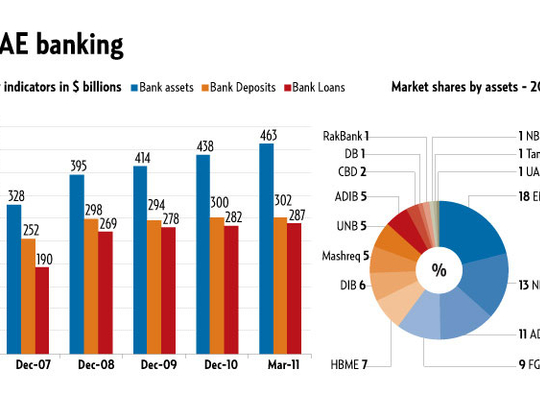
Dubai: International rating agency Moody's Investors Service said yesterday that the next 12 to 18 months could be challenging for the UAE banking system in terms of asset quality and profitability.
The rating agency said its outlook for the banking system is negative because of the ongoing trends of corporate deleveraging, asset quality challenges and the subdued profitability of UAE banks in the wake of continued provisioning needs. Moody's clarified that the outlook does not represent a projection on any change in ratings.
"Moody's negative outlook on the UAE banking system is mainly driven by the legacy asset quality challenges related to the ongoing restructuring of some large government-related borrowers," said Khalid Howladar, Vice President — Senior Credit Officer at Moody's Dubai office.
While liquidity has improved and capital buffers are strong, these factors are moderated by legacy asset quality risks, primarily related to the ongoing restructuring of some large government-related borrowers.
Deposit concentrations
"Limited transparency, sizeable related-party exposures and high loan and deposit concentrations will also continue to render many UAE banks vulnerable to name-specific risks," Howladar said.
The orderly conclusion of the $25 billion (Dh91.75 billion) Dubai World corporate debt restructuring is seen as supportive to the banking system although it resulted in impairments ranging from 10 per cent to 20 per cent on a net-present-value (NPV) basis. Moody's said yesterday that there are concerns on the $10 billion restructuring of Dubai Holding driving up the non-performing loans of UAE banks.
In addition to Dubai Holding, Moody's said there are other smaller government related issuers (GRIs) that are seeking refinance over the course of 2012.
"Work-outs of large distressed GRI exposures will continue to push up system-wide non-performing loans (NPLs). We expect that NPLs will peak next year in Dubai at around 13-15 per cent and this year in Abu Dhabi at lower level of around 8-10 per cent," said Nicolas Charnay, Associate Analyst with Moody's
The rating agency expect UAE to post real GDP growth of 3 per cent for 2011 and 2012, supported by higher oil revenues and government spending, well below the 7 per cent yearly average in the pre-crisis period.
Additionally, on a more macro level, the UAE's dependence on oil revenues and core sectors of trade, services, global logistics and tourism render the local economy more sensitive to global risk scenarios of weakened growth and recession.
Analysts believe that increased reliance of corporates in GRIs on local banks could weaken their balance sheets. "Our bank equity research team believes the domestic banking sector could handle 2012 loan refinancing should international banks not participate in the rollover. But it could push up NPLs of the banking sector," said Jean-Michel Saliba, an Economist with Bank of America Merrill Lynch.
Adequately capitalised
UAE banks have increased their capital over the past two years, and the system average Tier 1 for year-end 2010 was 14.3 per cett. Shareholder's equity is also relatively high on a global basis at around 12.6 per cent of total assets. "Our scenario analysis of system capital levels indicates that rated UAE banks are adequately positioned to absorb the credit losses under both our central and adverse case scenarios," said Howladar.
The rating agency considers that the UAE banks' liquidity metrics to be significantly improved with the ratio of liquid assets to total assets held reaching almost 25 per cent as of year-end 2010.
Although profitability is recovering, it remains constrained by cautious loan growth and the ongoing provisioning that is required to cover problem loans. These trends will continue to dampen banks' net profits for 2011 and into 2012.
"Overall, we expect bank lending growth to remain subdued over the remainder of 2011 at around 3-5 per cent, compared with 25 per cent in pre-crisis times. Among Abu Dhabi banks, we expect stronger economic growth to generate higher lending growth compared with Dubai banks," said Charnay.












